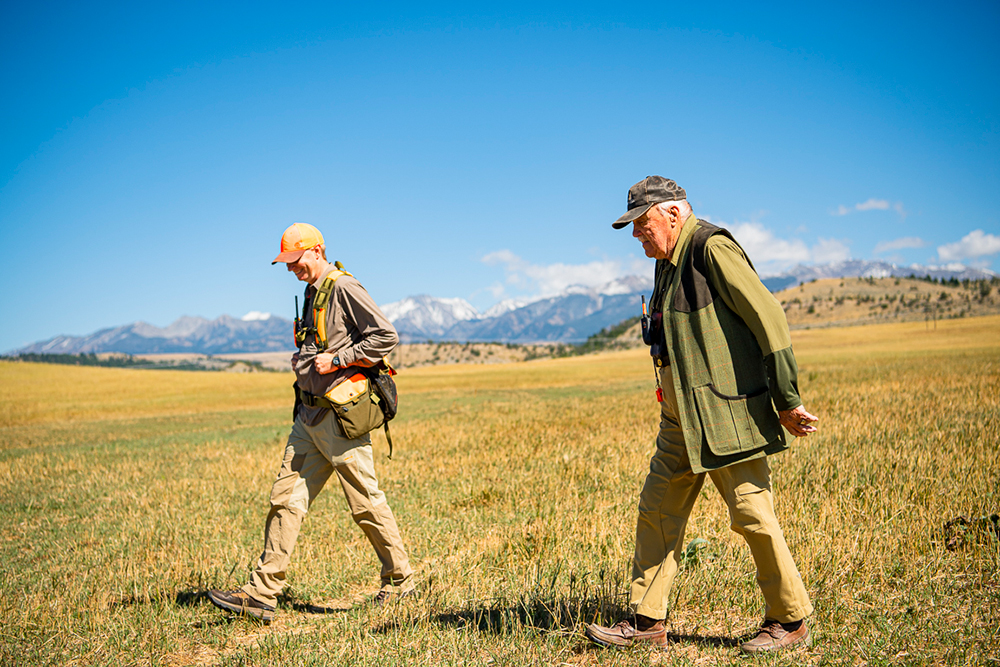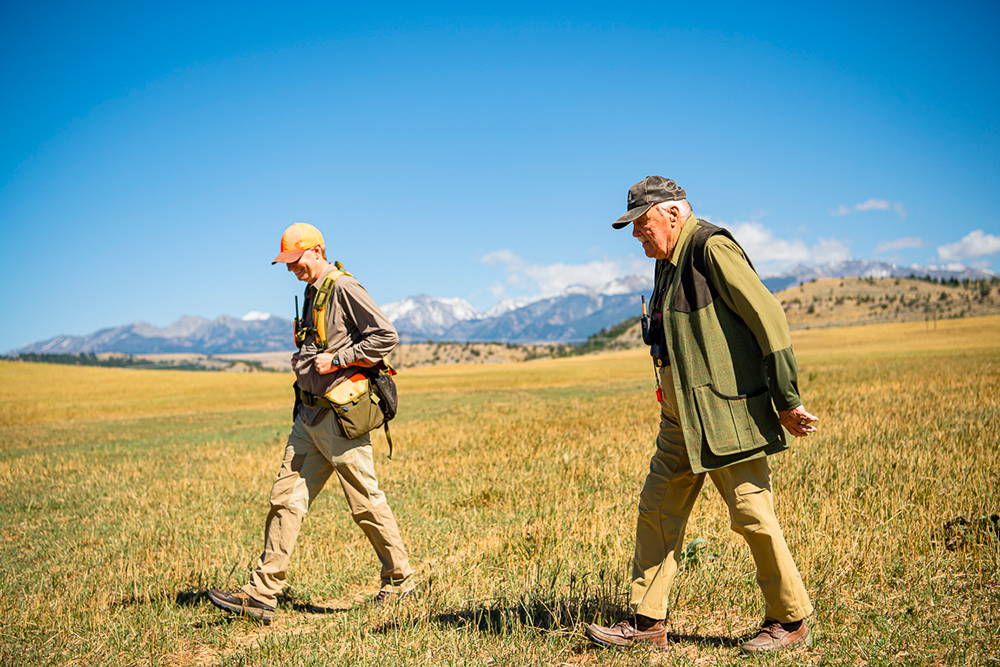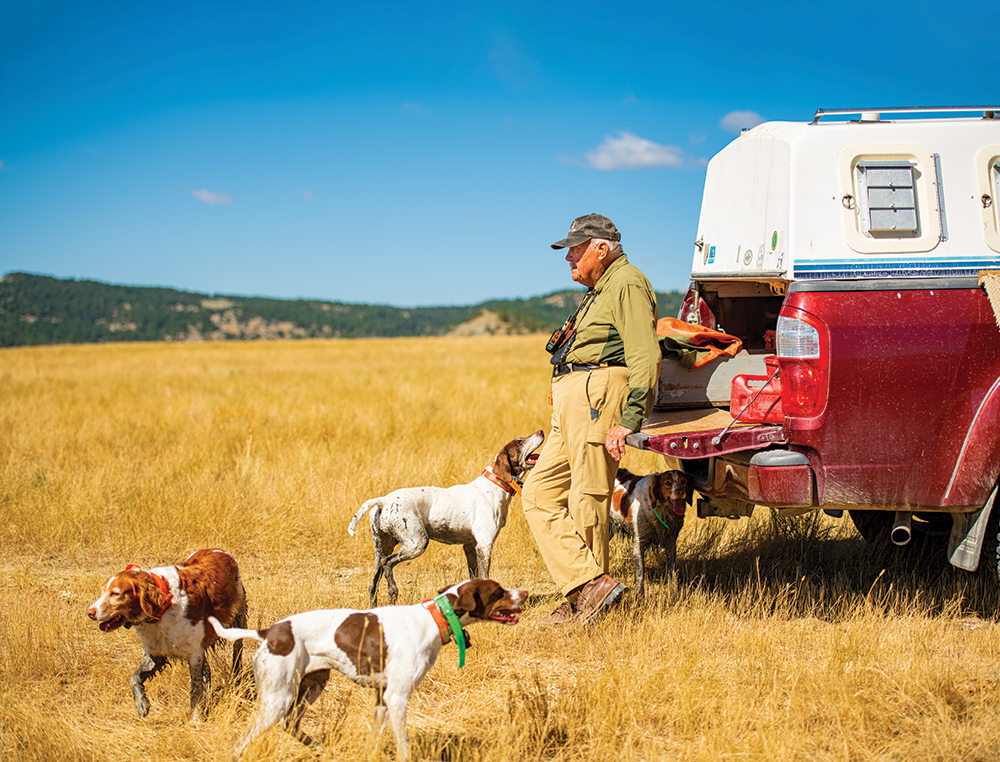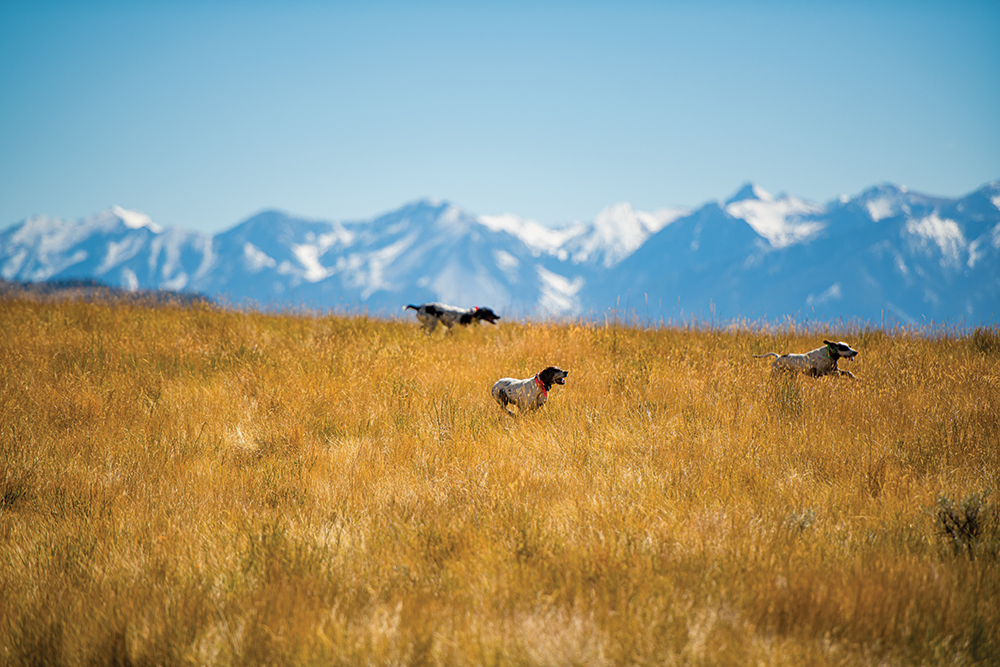A Walk with Ben

Montana legend says that a woman haunts the Crazy Mountains. She fled to its steep slopes for safety when her wagon train was attacked during the Western migration. From her trauma, the stories tell that she went mad. She watches over the area to ward off those who betrayed her. And, that’s how the Crazies got their name.
The saw-toothed ridges that extend from rocky headwalls cast a menacing shadow over the vast valleys and running rivers below. There, a basin of native grassland lies within earshot of bugling elk on the mountainside. Brown trout swim and slurp in the Yellowstone River nearby. Sharptails and Huns call this piece of prairie their home. And the legend of the crazy woman protects the beauty within.
For over five decades, one man has walked on this land at his own pace. He wanders the hills with his bird dogs running along. Sometimes he carries a gun. Sometimes he does not. Yet, the spirit of the woman who haunts this place has granted him amnesty. For this man cares about the flora and the fauna that she protects. And he is a teacher. The future of the land’s integrity matters to him, too, and therefore the woman haunts him no more.
The man has walked many miles over many years there in search of birds. He always strides with his hands behind his back. His pace is calm and gentle. A signature hat shields his nose and neck from the midday sun. The man is a prodigious noticer. His eyes always seek the horizon to watch what goes on before him.
A manmade bridge over a small stream leads to a fork in the road. One way winds upward through a rocky bluff you cannot see beyond. The other takes the easier route toward a glistening pond. But both lead to adventure. Rows of trees line occasional coulees while randomly placed bushes dot the landscape. All could hold birds. With a heavy vest at hunt’s end, a hidden waterfall presents an oasis fit for cleaning feathered treasures to take home. The man has documented the intricate details of all these moments at one time or another.

Each story is about the dogs. The man shot many birds when he was young and spry. But over time, shooting fades out of focus and killing is less of the goal. He cares about his dogs and the birds and the habitat that support his love for the land.
His dogs run big on the prairie. The view ahead reveals running Brittanys as far as you can see with mountains providing a fitting backdrop. And sometimes the dogs stop staunch. For this is bird country. And, his dogs found a covey. Because of this, the man walks towards them with a smile.
He was the first to hunt birds in this place, and few have walked with him since. But for those who have had the pleasure, they understand the gravity of the situation. They follow along at the same calm and gentle pace. They quickly learn to notice the dogs and the stunning views and all that goes on around them. They learn to take advantage of every second of the hunt. With this man, every step is a story. And, they all need to be told.
If you haven’t already figured it out, this man is Ben O. Williams, a true upland icon. He is a hunter, dog owner, and fisherman. He is a photographer, writer, and artist. But beyond all, he is a teacher and a true gentleman at that. He has been hunting this land in Central Montana since the early 1960s. He just turned 89 years old and is still walking with his dogs in search of birds and teaching those willing to listen.

Ben and his wife, Bobbie, live near Livingston, Montana, in the Yellowstone Valley between the Beartooth and Absaroka Mountains. Ben’s destiny was to be in Montana, but it didn’t start out that obvious for him. He grew up in Illinois, where he first gained a love for the rise of a quail covey. It was his sense for adventure and running bird dogs, of course, that later sent him west.
Ben had a paper route as a boy. He thumbed through a Montgomery Ward catalog, and with that money earned, he bought a shotgun for $28.50. That first gun was a Stevens .410 with a plastic stock. His first dog was the family dog named Mike, a gun-shy springer spaniel. We all start somewhere, and he loves to tell these boyhood stories with a chuckle and a smile.
He would follow his grandfather in the fields to hunt wild birds beyond their backyard. There was a railroad nearby that led to his school, and although his mother didn’t approve, he’d take his Stevens to hunt on his morning walk. He even let the springer tag along. He’d hide his gun in the woods outside the classroom, and Mike would wait for him until school was done. The two would then hunt together on the way back home. He romantically recalls his first pheasant flush and the fact that he missed the shot. Yet, these simple, albeit amazing, memories infected him with the hunting fever forever.
You can’t talk about the legacy of Ben O. Williams without discussing Brittanys. These dogs became a part of Ben’s life at a young age. In 1956, he was going to college in Illinois. He decided he wanted a bird dog of his own, a setter at the time. After asking around, he stumbled upon a local dog breeder who had the first Brittanys in the United States. Ben liked these dogs. The breeder was looking for a dog trainer. Being a student, Ben didn’t have a lot of money and was interested in helping out. He inquired but acknowledged he didn’t have much for experience. The breeder responded, “You don’t need to know how to train a Brittany. They’ll train you.”
So goes the beginning of Ben’s passion for Brittanys. He trained 60 dogs in four years in Illinois. He earned his college degree in industrial design and architecture and taught high school there for one year. He loved to teach but sought a new adventure. So in 1960, Ben and Bobbie took two young dogs with them and headed to Washington State when Ben was 26 years old. He was the first to bring Brittanys to the West.

Ben earned a teaching job in Leavenworth, Washington, and on his way, he got his first taste of Montana while fishing in Yellowstone National Park. For two years while teaching in Washington, he hunted blue and ruffed grouse, and found enough Huns to fall in love. To Ben, Huns were just big quail in a place where the covey rises sounded like a squeaky gate and reminded him of his boyhood days.
With open summers, he worked as a naturalist at Yellowstone. He enjoyed hosting hikers and teaching campers about the plants and animals of the park. He waxes poetic about the numbers of trout he’d catch in the evenings after work. Montana spoke to Ben’s soul. And despite the rain and snow and winter weather, he convinced Bobbie, bless her heart, that Montana was where they were meant to be.
Ben and Bobbie and two Brittanys moved to Livingston, Montana, in 1962. He taught high school art and earned his masters of art degree in sculpting. In fact, he is a renowned sculptor in his own right with impressive statues featured throughout the nation. He retired in 1986 after 30 years.
As one would expect, Ben taught school by day and hunted birds by night. Every afternoon when the school bell rang, he would pick up Bobbie and the dogs in their trusty, blue Volkswagen Bug and drive the gravel roads to the fields north of the river. He was known in town as the crazy guy with the Volks who hunted birds with dogs. The locals would question why and how you would hunt Huns that way. Ben would confidently reply, “Well, I’ll show you.”
To Ben, it is not “hunting” Huns…it is “chasing” Huns. He was one of the first to actually target Huns in Montana. He found them while scouting the valleys beneath the Crazies for antelope. This is the same place he hunts Huns to this day, 60 years later. Back then, he could bag a limit by 10 a.m. and then have time to cool down by pursuing blue grouse in the mountains or by wetting a fly in the Yellowstone River or surrounding tributaries the rest of the day. Today, he likes to run dogs, but doesn’t prefer to kill Huns anymore. Instead at the flush, he’ll simply point his finger at them and say, “Bang.”
Ben likes to collect shotguns and write about them. The boy who started with a Stevens moved on to a Lefever and later used a Browning Superposed 20-gauge as his primary Hun gun for many years. Over his lifetime, he has owned over 50 collector shotguns, including Churchills, Purdeys, a Boss, and currently a matched pair of Westley Richards in their original case that were built in 1926.
After Ben moved to Livingston, he ran into Delmar Smith at Dan Bailey’s Fly Shop in town and asked him what he knew about Brittanys. Delmar recommended that Ben contact a breeder from the Texas Panhandle who ran Brittanys on horseback. Ben did so and bought a big-running male to start his kennel back home. He focused on vast range and white dogs that could be seen far on the horizon. True to his high standards and utmost respect for his dogs, he named his kennel Williams Pride Brittanys.

After starting with two dogs in the field, his Hun hunting evolved into running four dogs at a time, which were mostly Brittanys for many years. His many days hunting across the country eventually required that he traveled with three groups of four at a time. At most, he had 14 dogs, including English pointers and Brittanys from Georgia, Oklahoma, and Minnesota.
If you ask him about a particular dog that he remembers, he’ll probably talk about Winston, a Brittany he wrote a book about to commemorate their adventures together. Winston hunted every gamebird in North America with Ben. You name a species and place, and Ben and Winston probably hunted there a time or two. One year, he wanted to shoot a double on every gamebird on the continent. He nearly met his goal, but one Mearns’s quail got away on the second shot. He admits that Mountain quail were the hardest piece of the puzzle. Despite the Mearns’s miss, this epic feat is tough to beat.
These days, when he opens the kennel door, Ben simply smiles when his dogs bark. He has six: four pointers and two Brittanys. He’s particularly fond of a young pointer named Bonnie. He lets her out to take her throne on a leather chair in his garage near his collection of Double Gun Journals and a cabinet full of photograph slides. He’s so patient while Bonnie strains for attention from everyone around. Boy, does this dog run. Ben likes that. She’s carrying on the Williams Pride tradition.
Most of us know Ben as a writer based on his well-known books: The Best Day Yet, Huns & Hun Hunting, Hunting the Quails of North America, Bird Dog—The Instinctive Training Method, and Winston. But he is quick to admit, “I was a bird hunter and a biologist and a naturalist and a dog guy first…and a writer second.”
In fact, Ben got his start in the outdoor media world through his photography. In 1954, he bought his first Nikon camera overseas while serving his country in the Navy for four years in the Korean War. These cameras weren’t even available in the United States back then. He has been a photographer ever since. He has over 50,000 slides that capture beloved images of dogs, birds, and friends from the beginning of his upland career to this day.
He started selling photos to Ed Gray of Gray’s Sporting Journal, who first asked him to write stories. He didn’t want to at the time, but over years his writing grew in not only volume but in popularity. Through his writing for Gray’s, Gun Dog, Pointing Dog Journal, and others, he has become a household writer in the upland world. He has written over 50 articles for Covey Rise since its inception 10 years ago.

When asked if he likes writing, Ben borrows a paraphrased line from Norman McLean by saying, “I don’t consider myself a writer. I’m a storyteller.” Ben is a natural-born storyteller. His superpower is that he is authentic and real. His passion for nature and biology comes through in his message. He loves to share his memories from days afield, and he has a lot of them. He is a teacher and has been his whole life.
Ben writes his stories from his office desk with a view of the mountains through his window. This is the place where he has been putting pen to paper for over 50 years. Above that desk is a photo of him with multiple Brittanys sitting and staring back at him. The photo is aptly titled “Holding Class.” He uses his experiences as a teacher and as a naturalist to hold class with every article he writes.
If we care about the past as much as the future of our traditions, we can thank our lucky stars that storytellers like Ben O. Williams have shared their talents with us for so long. His work in both magazines and books are documented for eternity in print for our children and grandchildren to learn and enjoy.
When you receive a message from Ben, you listen.
Hi Matt. Ben Williams, Livingston, Montana. Anyway, I’m trying to put something together that you might be interested in. I thought that maybe sometime in September you might come out to hunt the old place. You could stay for a couple of days. Anyway, if you are interested, give me a call, and we can set up some dates. I’m seeing some sharptails and few Huns, but it’s early. So, I think it would work out good for your young dog. Feel free to give me a call. Take care. Bye.
When you receive an invite from Ben, you go without question. None of us ever know how many more days we have left to hunt and fish. And, you never let a chance to hunt with a legend pass you by.
That September, we hunted hard in the morning on the old place beneath the Crazies. We trekked further than I thought we would. I listened to every word Ben said and let the lessons sink in. My old dog stuck a covey on the ridgetop, but I was below the slope and slow to the show. As the squeaky gate sounded the flush, all too far for a shot, all I could do was raise my gun and say, “Bang.” I was okay with that.
At lunchtime, we jumped in the truck to find another spot. Dogs panted in the back seat as we drove the gravel trail, crossed the bridge over the creek, and approached the fork in the road. We took a left, traveled far enough to hear a story or two, and parked near the hidden waterfall on the prairie. There we sat on the tailgate to share a sack lunch that Bobbie prepared for us, bless her heart.
We talked for a while about our love for hunting, magazines, and family. I didn’t know if it was my place to ask, but I felt it was okay anyway. “Do you have any regrets?”
“For what?” Ben gruffly replied.
“With anything related to hunting or dogs or life?”
“Nah,” Ben said. “The only regret that I have is that I haven’t been fair to these last dogs for the number of times I used to hunt when I was young. We still hunt a lot, but not as much as I used to. I got this little pointer last year, Bonnie, ya know. Sometimes I think I shouldn’t have, but I try to run her as much as I can. I like to watch her run. No matter what, she’s nice to have around.”
I nodded but didn’t reply. I understood his sentiment. He’ll always carry the utmost care and respect for his dogs.
Ben then said, “This afternoon, I want you to take your young dog and shoot this gun.”
“The Westley?” I asked.
“Yep,” is all he said.
For those of us lucky enough to take a walk with Ben, we understand the gravity of the situation. Every step is a story. And, they all need to be told.
Originally published in Volume 9, Number 6 (Oct-Nov 2021) of Covey Rise
























